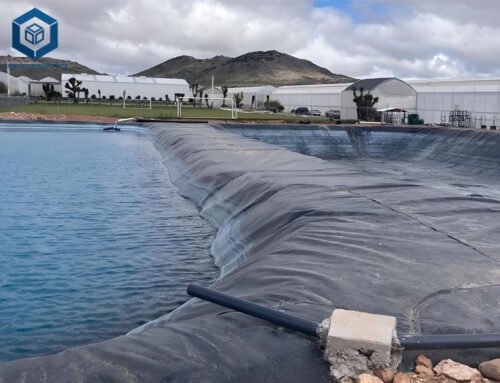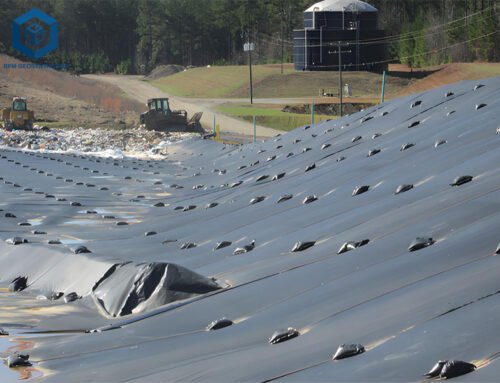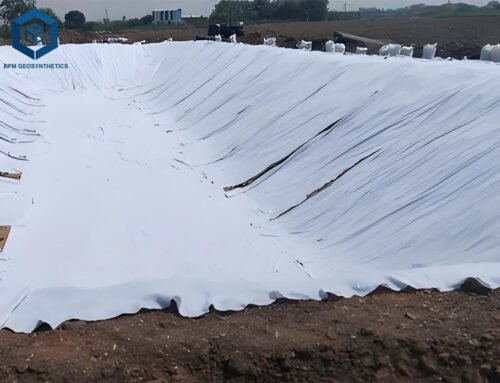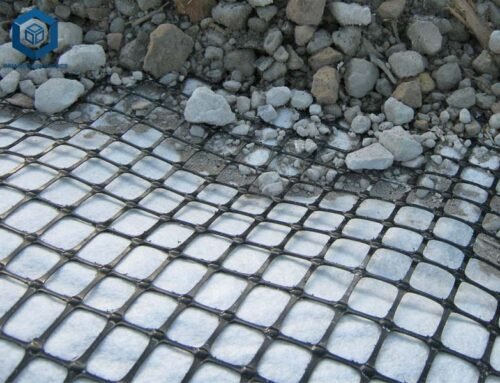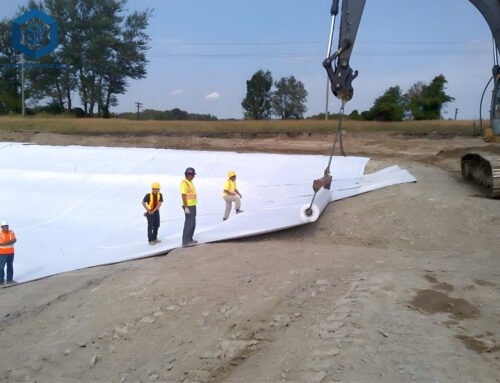In the intricate domain of civil engineering and construction, the careful selection of materials is fundamental to the structural integrity, environmental protection, and long-term performance of any project. Geosynthetics, a class of synthetic products used in conjunction with soil, rock, or earth, have become indispensable for various applications, from robust infrastructure to critical environmental containment. Differences of Geomembrane vs Geocell – Within this diverse category, geomembranes and geocells are two powerful tools, each designed to address specific geotechnical challenges, yet often confused due to their shared polymeric composition and role in ground improvement.
While both contribute significantly to modern construction practices, geomembranes and geocells possess fundamentally distinct primary functions, physical structures, and mechanisms of interaction with soil. A comprehensive understanding of these differences is crucial for engineers, designers, and project managers to optimize material selection, ensure project success, and achieve the most efficient and sustainable outcomes. This in-depth guide aims to demystify the roles of geomembranes and geocells, providing detailed insights into their unique characteristics, applications, and performance parameters, allowing “data to speak” in guiding informed decision-making.
1. What is a Geomembrane?
A geomembrane is an essentially impermeable synthetic membrane liner or barrier used in conjunction with any geotechnical engineering-related material to control fluid (liquid or gas) migration in a human-made project, structure, or system. In essence, it acts as a very low permeability barrier. Geomembranes are manufactured as continuous, thin sheets from various polymeric materials, designed to prevent the seepage of liquids or gases, thereby protecting soil, groundwater, and the environment from contamination.
The evolution of geomembranes marked a significant leap in containment technology, offering a robust and reliable solution for managing hazardous waste, conserving water, and creating safe storage facilities. Their widespread adoption is largely due to their excellent chemical resistance, UV stability, and mechanical strength, making them indispensable in numerous environmental and civil engineering applications.
1.1 Types of Geomembranes:
Geomembranes are primarily classified by their polymeric resin, each offering a unique set of properties for specific applications:
1.1.1 HDPE (High-Density Polyethylene) Geomembrane:
- Characteristics:The most commonly used geomembrane. Known for its high density (≥ 0.94 g/cm³), excellent chemical resistance, high tensile strength (e.g., 27 kN/m for 1.5mm thick, per ASTM D6693), superior puncture resistance (e.g., 800-1000 N for 1.5mm thick, per ASTM D4833), and UV stability (due to carbon black content, typically 2-3%). It is rigid and less flexible than LLDPE.
- Typical Thicknesses:Ranging from 0.75 mm (30 mil) to 2.5 mm (100 mil) or thicker, with 1.5 mm (60 mil) being very common for landfills.
- Applications:Landfill liners and caps, mining heap leach pads, wastewater treatment lagoons, large agricultural ponds, and demanding chemical containment.
1.1.2 LLDPE (Linear Low-Density Polyethylene) Geomembrane:
- Characteristics:More flexible and pliable than HDPE (density ≤ 0.94 g/cm³), making it easier to install on irregular surfaces and less susceptible to stress cracking. It offers higher elongation at break (e.g., 700-800% vs. 12-15% for HDPE, ultimate elongation, ASTM D6693) but generally slightly lower chemical resistance and tensile strength than HDPE of the same thickness.
- Typical Thicknesses:Similar to HDPE, ranging from 0.75 mm to 2.0 mm.
- Applications:Decorative ponds, golf course lakes, aquaculture (fish farms), canals, and applications requiring flexibility or accommodating minor differential settlement.
1.1.3 PVC (Polyvinyl Chloride) Geomembrane:
- Characteristics:Highly flexible, relatively lightweight, and easy to fabricate (can be seamed with adhesives or heat). However, it has lower chemical resistance and UV stability compared to polyethylenes and can become brittle in cold temperatures. Often contains plasticizers which can leach out over time.
- Typical Thicknesses:Commonly 0.75 mm (30 mil) to 1.5 mm (60 mil).
- Applications:Smaller decorative ponds, temporary covers, and some industrial containment where specific chemical compatibility is met.
1.1.4 EPDM (Ethylene Propylene Diene Monomer) Geomembrane:
- Characteristics:A synthetic rubber known for its exceptional elasticity (up to 300% elongation), UV stability, and temperature resistance. It is highly flexible and conforms well to complex contours.
- Typical Thicknesses:Typically 1.0 mm (45 mil) to 1.5 mm (60 mil).
- Applications:Residential and commercial ponds, green roofs, and other applications where flexibility and long-term weathering are paramount.
1.1.5 Specialty Geomembranes:
- Include XR-5 (fabric-reinforced high-strength PVC/alloy), Hypalon (CSPE), and others, used for highly specific chemical resistance or extreme temperature applications.
1.2 Key Properties and Specifications of Geomembranes:
The performance of a geomembrane is defined by several critical properties, evaluated through standardized tests (e.g., ASTM):
- Tensile Strength (kN/m or lbs/in):The maximum stress a geomembrane can withstand before breaking. ASTM D6693 (Wide Width Tensile) is common. For 1.5mm HDPE, specified tensile strength can be 27 kN/m, while LLDPE might be 20 kN/m at break.
- Elongation at Break (%):The percentage increase in length before the geomembrane ruptures. This indicates flexibility and ability to accommodate differential settlement. LLDPE has significantly higher elongation (e.g., 700-800%) than HDPE (e.g., 12-15% at break).
- Puncture Resistance (N or lbs):The ability to resist damage from localized forces. ASTM D4833 (Cone Puncture). For 1.5mm HDPE, values often exceed 800 N.
- Tear Resistance (N or lbs):Resistance to tearing. ASTM D1004 (Graves Tear) or D6243 (Trapezoidal Tear). For 1.5mm HDPE, tear resistance can be 200-300 N.
- Permeability (cm/sec):A critical parameter, defining how easily fluids can pass through. Geomembranes are engineered for very low permeability, typically less than 1×10−13 cm/sec. This is measured indirectly through various tests ensuring integrity and impermeability.
- Density (g/cm³):Influences mechanical properties. HDPE > 0.94 g/cm³, LLDPE ≤ 0.94 g/cm³. ASTM D1505.
- UV Resistance:Stability under prolonged exposure to ultraviolet radiation, usually enhanced by carbon black content (ASTM D1603 for carbon black content, ASTM D7238 for UV exposure resistance).
- Chemical Resistance:Ability to withstand degradation from various chemicals (ASTM D5747 for immersion tests).
- Stress Crack Resistance (ESCR):Resistance to cracking under sustained stress in the presence of certain chemicals (ASTM D1693). HDPE typically has excellent ESCR.
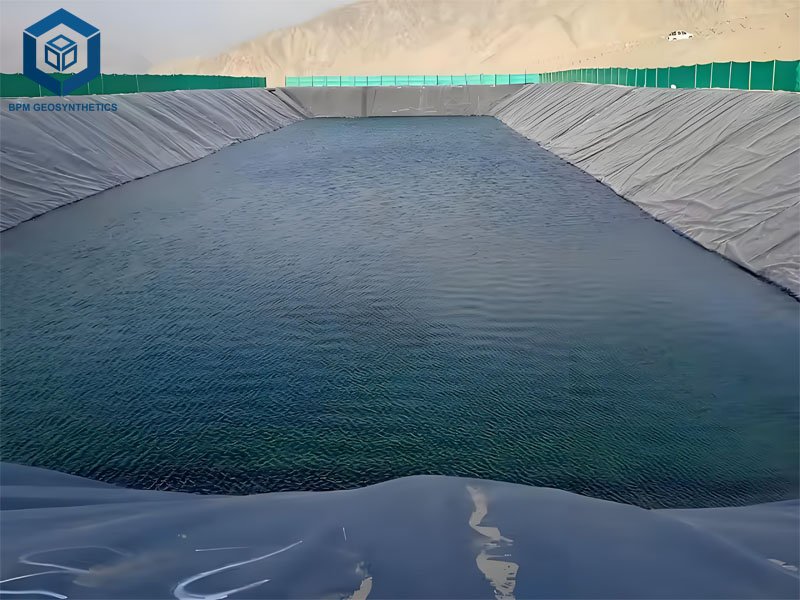

2. What is a Geocell?
A geocell, also known as a cellular confinement system (CCS), is a three-dimensional, honeycomb-like structure made from strips of polymeric material (typically HDPE) that are ultrasonically welded together at intervals. When expanded on site, these strips form a robust cellular matrix that can be filled with various infill materials such as soil, aggregate, concrete, or even recycled materials. The primary function of a geocell is confinement and stabilization of infill material, which enhances its load-bearing capacity and resistance to erosion.
The geocell technology was initially developed by the U.S. Army Corps of Engineers in the late 1970s (with Presto Geosystems’ GEOWEB being the pioneering product). Its innovation lies in transforming weak, unconsolidated infill materials into a stiff, stable mattress or slab, thereby improving soil performance in applications ranging from load support to slope protection.
2.1 Types of Geocells:
Geocells are primarily distinguished by their manufacturing process, cell geometry, and wall perforation:
2.1.1 Perforated Geocells:Most common type, featuring small holes or perforations on the cell walls.
- Characteristics:Allow for lateral drainage of water and facilitate root penetration when vegetated, promoting better biological integration and long-term stability in vegetated slope applications. The perforations also enhance frictional interlock with the infill.
- Typical Applications:Vegetated slope stabilization, permeable pavement systems, and applications where drainage is critical.
2.1.2 Non-Perforated Geocells:Designed with solid cell walls.
- Characteristics:Primarily used where fluid containment within the cells is desired (e.g., for containing concrete) or where the structural integrity of the cell wall is paramount without requiring drainage through the walls.
- Typical Applications:Certain types of channel lining where fluid flow is high, or for containment of specific infill materials.
2.1.3 Textured vs. Smooth Geocells:
Some geocells have textured (roughened) surfaces on their cell walls, which increases the frictional resistance between the geocell and the infill material, enhancing load transfer and stability. Smooth-walled geocells are easier to clean and might be preferred for some specific applications.
2.1.4 Cell Height and Section Length:
Geocells come in various cell heights (e.g., 50 mm, 75 mm, 100 mm, 150 mm, 200 mm, 250 mm) and section lengths to accommodate different load requirements and slope gradients. Larger cell heights provide greater confinement and are suitable for heavier loads or steeper slopes.
2.2 Key Properties and Specifications of Geocells:
The performance of a geocell system is governed by the properties of the geocell material and its interaction with the infill:
- Panel Material:Typically made from virgin HDPE. Key properties include density (e.g., 0.935-0.965 g/cm³, ASTM D1505), tensile strength of the sheet (e.g., 20-30 MPa), and environmental stress crack resistance (ESCR, ASTM D1693, >400 hours). Carbon black content (1.5-2.0%, ASTM D1603) ensures UV resistance.
- Weld Strength (kN/m or lbs/in):The strength of the ultrasonic welds connecting the individual strips. This is critical for the integrity of the cellular matrix. ASTM D5721 (Weld Shear Strength) and ASTM D6392 (Peel Strength) are important tests. Weld strength can be 70-80% of the sheet’s tensile strength.
- Cell Height (mm):The vertical dimension of the individual cells, influencing confinement and load distribution. Higher cells provide greater confinement for a given infill.
- Aperture Opening/Cell Size:The dimension of the individual cells when expanded. Smaller cell sizes provide greater confinement for finer infill materials.
- Perforation Rate (%):For perforated geocells, the percentage of the cell wall surface that is perforated, impacting drainage and root interlock.
- Infill Material Properties:The type, density, and gradation of the infill material (e.g., sand, gravel, topsoil, concrete) significantly influence the overall performance of the geocell system.
- Modulus Improvement Factor (MIF):A key performance metric for load support applications, indicating how much the geocell system increases the elastic modulus (stiffness) of the infill material. MIF values can range from 3 to 10 or more, significantly enhancing bearing capacity.
3. What Are Similarities of Geomembrane and Geocell?
Despite their primary functional differences, geomembranes and geocells share several common characteristics that place them both within the broad category of “geosynthetics” and contribute to their widespread adoption in civil engineering.
3.1 Polymeric Composition:
Both materials are predominantly manufactured from synthetic polymers, primarily high-density polyethylene (HDPE). Other polymers like LLDPE, PVC, and EPDM are used for geomembranes, while geocells are almost exclusively HDPE. This synthetic nature provides inherent resistance to biological degradation (e.g., rot, mildew, insects), chemical attack (from common soil acids, alkalis, and salts), and environmental aging processes, ensuring long-term performance in buried applications.
3.2 Application in Geotechnical Engineering:
Both geomembranes and geocells are engineered solutions designed to interact with soil, rock, and other geotechnical materials to improve ground performance and enhance project stability. They are not standalone solutions but rather integral components of a larger civil engineering system.
3.3 Durability and Environmental Resistance:
Both types of geosynthetics are engineered for long design lives, often exceeding the lifespan of traditional construction materials. They exhibit excellent resistance to UV radiation (when properly stabilized with carbon black for exposed applications), environmental stress cracking, and the harsh conditions encountered in soil. Their inert nature means they do not leach harmful substances into the environment, contributing to responsible construction.
3.4 Contribution to Sustainable Practices:
By optimizing material usage and enhancing the performance of local, readily available infill materials (in the case of geocells) or preventing environmental contamination (in the case of geomembranes), both technologies contribute to more sustainable construction practices. They can reduce the need for expensive imported aggregates, minimize waste generation, and protect natural resources.
3.5 Industry Standards and Quality Control:
The manufacturing and testing of both geomembranes and geocells adhere to rigorous industry standards established by organizations such as ASTM International, ISO, and the Geosynthetic Institute (GRI). These standards ensure consistent product quality, predictable performance, and enable engineers to confidently specify materials based on measurable parameters (e.g., ASTM D6693 for geomembrane tensile properties, ASTM D5199 for geocell sheet thickness, ASTM D5721 for geocell weld shear strength).
4. What Are Differences of Geomembrane vs Geocell?
The fundamental Differences of Geomembrane vs Geocell stem from their distinct primary functions and, consequently, their unique physical structures and mechanical behaviors.
4.1 Differences of Geomembrane vs Geocell – Primary Function and Mechanism:
4.1.1 Geomembrane: Containment and Barrier
- Mechanism:The core function of a geomembrane is impermeability. It acts as a fluid barrier (liquid or gas) to prevent migration. This is achieved by creating a continuous, low-permeability sheet that physically blocks the passage of fluids. Its performance relies on maintaining an unbroken barrier. This makes it crucial for preventing leakage, controlling contamination, or retaining valuable liquids/gases.
4.1.2 Geocell: Confinement and Stabilization
- Mechanism:The primary function of a geocell is three-dimensional confinement and stabilization of infill material. When expanded and filled, the interconnected cells create a stiff, semi-rigid mattress. The cell walls prevent the lateral movement of the infill, enhancing its shear strength, stiffness, and load distribution capabilities. This effectively transforms weak or unstable soil into a more robust composite structure, often referred to as a “cellular confinement” mechanism.
4.2 Differences of Geomembrane vs Geocell – Physical Structure and Form:
4.2.1 Geomembrane:
- Structure:A continuous, relatively thin, impermeable sheet or film. It is typically supplied in large rolls and installed as large panels, which are then seamed together (e.g., by welding) to create a continuous barrier. Its form is essentially two-dimensional before installation.
- Apertures/Openings:None, by design, as its purpose is to be impermeable.
4.2.2 Geocell:
- Structure:A three-dimensional, expandable, honeycomb-like cellular structure. It is supplied in a collapsed, folded configuration for transport and expands into a distinct 3D cellular matrix when deployed on-site. The structure is characterized by interconnected cells of a specific height and opening size.
- Apertures/Openings:Defined cell openings that are filled with infill material. The presence of these openings is fundamental to its confinement function.
4.3 Differences of Geomembrane vs Geocell – Permeability vs. Impermeability:
4.3.1 Geomembrane:
- Permeability:Fundamentally impermeable. Its design goal is to have extremely low hydraulic conductivity (typically <1×10−13 cm/sec), effectively blocking water or gas flow.
4.3.2 Geocell:
- Permeability:The geocell walls themselves are impermeable (typically HDPE), but the overall geocell system (cells filled with infill) is permeable as water can drain through the infill material and, in the case of perforated geocells, through the cell walls. Geocells do not prevent fluid migration through the entire system; they confine the infill.
4.4 Differences of Geomembrane vs Geocell – Tensile Strength and Load Transfer:
4.4.1 Geomembrane:
- Tensile Strength:Possesses high tensile strength, but its primary function is not to transfer or distribute large structural loads in the same way as a geogrid or a confined geocell system. Its strength primarily relates to its ability to resist tearing, puncturing, and elongating while maintaining its barrier integrity under various stresses.
- Load Transfer:Transfers loads through its ability to resist punctures and tears, maintaining its barrier integrity. It does not mechanically interlock with soil to enhance its bearing capacity in the same manner as a geocell or geogrid.
4.4.2 Geocell:
- Tensile Strength:The individual cell walls have tensile strength (from the HDPE material), and the weld strength is critical. However, the system’s strength comes from the confinement of the infill material, which significantly increases the composite’s apparent cohesion and stiffness.
- Load Transfer:Effectively transfers and distributes loads by creating a semi-rigid mattress or slab. The confinement mechanism prevents lateral spreading of the infill, leading to increased bearing capacity and reduced settlement. This is achieved by creating a “beam effect” or “slab effect” where the confined infill and geocell act as a composite. The Modulus Improvement Factor (MIF) of a geocell system can be 3 to 10 times that of unconfined soil.
4.5 Differences of Geomembrane vs Geocell – Key Applications:
4.5.1 Geomembrane Applications (Primarily Containment):
- Waste Management:Landfill liners (municipal, hazardous, industrial), landfill caps/covers.
- Water Management:Pond liners (decorative, agricultural, industrial), canal liners, reservoirs, dam facings, wastewater treatment lagoons, floating covers.
- Mining:Heap leach pads, tailings impoundments, process water containment.
- Oil & Gas:Frac ponds, secondary containment for tank farms, drilling sumps.
- Environmental Remediation:Contaminated soil encapsulation, fluid barriers in remediation sites.
4.5.2 Geocell Applications (Primarily Confinement and Stabilization):
- Load Support/Base Stabilization:Unpaved roads, access roads, railways, parking lots, heavy load platforms over soft subgrades. Increases the effective bearing capacity of the soil.
- Slope Stabilization:Erosion control on steep slopes and embankments, creating stable vegetated surfaces. This helps prevent surficial erosion and provides long-term stability.
- Channel Protection:Lining of drainage channels, ditches, and spillways to resist erosive forces from flowing water. Can be vegetated or filled with aggregate/concrete.
- Retaining Walls:Gravity retaining walls and reinforced earth structures, using vegetated geocell layers to stabilize the face and internal soil mass.
- Root Protection:Protecting tree root zones in construction areas.
4.6 Differences of Geomembrane vs Geocell – Installation Methods and Site Preparation:
4.6.1 Geomembrane Installation:
- Site Prep:Requires meticulous subgrade preparation – smooth, free of sharp objects, often with a geotextile underlayment for protection.
- Deployment:Large, heavy panels are unrolled.
- Seaming:Critical step involving specialized equipment like hot-wedge welders or extrusion welders to create robust, impermeable seams between panels. Quality assurance/quality control (QA/QC) testing of seams is paramount (e.g., destructive and non-destructive testing per ASTM D6392, D7746).
- Anchoring:Typically anchored in trenches around the perimeter.
4.6.2 Geocell Installation:
- Site Prep:Requires a prepared subgrade, but generally less stringent than for geomembranes. A geotextile separator might be used underneath to prevent intermixing.
- Deployment:Sections are expanded like an accordion.
- Anchoring:Secured to the subgrade using rebar stakes, pins, or deadman anchors to prevent movement, especially on slopes.
- Infill:Cells are filled with chosen material (soil, aggregate, concrete) and compacted.
- No Seaming:Unlike geomembranes, geocells are typically connected via mechanical connectors or staples, not heat-welded seams, to form larger sections.
4.7 Differences of Geomembrane vs Geocell – Cost Implications:
4.7.1 Geomembrane Cost:
Varies significantly by material type and thickness. HDPE, for example, might range from $0.50 to $2.00+ per square foot depending on thickness and project size. Installation costs are often substantial due to specialized equipment (welding machines) and skilled labor required for proper seaming and QA/QC.
4.7.2 Geocell Cost:
Also varies by cell height, material, and type (perforated/non-perforated). Material cost per square meter can be lower than geomembranes for some applications, but the cost of infill material and its placement must be considered. Overall system cost can be highly competitive, especially when using locally sourced infill, which reduces transportation costs significantly. Geocells can often reduce the required thickness of expensive aggregate layers by 30-50%, leading to substantial material savings.
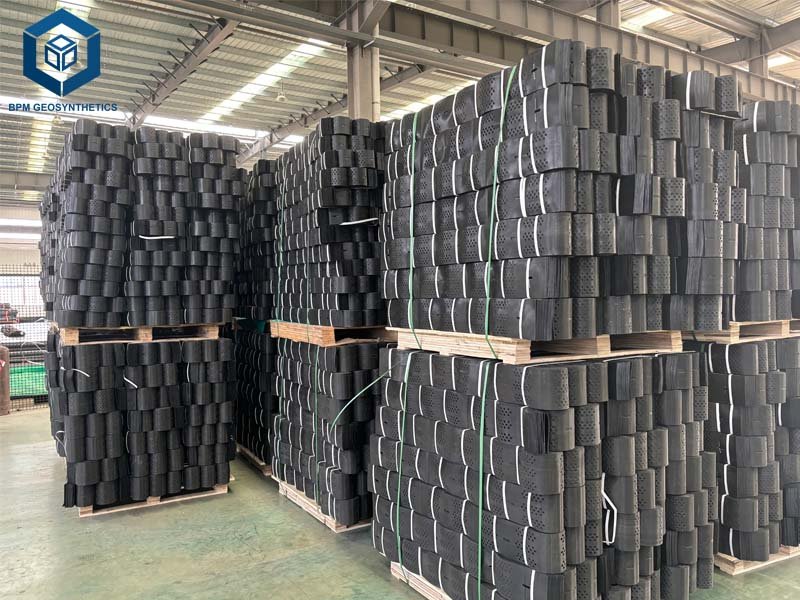

5. What Are Considerations When Choosing Between Geomembrane vs Geocell?
Selecting the appropriate geosynthetic requires a detailed analysis of the project’s specific needs and site conditions.
5.1 Project Objective and Required Function:
- Containment/Impermeability:If the primary goal is to prevent fluid migration (e.g., water, leachate, hazardous chemicals, gas), a geomembrane is the unequivocal choice.
- Soil Confinement/Stabilization/Load Support/Erosion Control:If the goal is to enhance the load-bearing capacity of weak soils, stabilize slopes against erosion, or protect channels, a geocell system is the appropriate solution.
5.2 Site Conditions and Environmental Exposure:
- Chemical Compatibility:For chemical containment, the specific chemical resistance of the geomembrane material (HDPE, LLDPE, PVC, XR-5) must be carefully matched to the contained fluid.
- Subgrade Stability:For very soft or unstable subgrades, a geocell can provide immediate load distribution and bearing capacity improvement, while a geomembrane on such a subgrade would likely require extensive subgrade improvement or a geotextile cushion layer.
- UV Exposure:For exposed applications (e.g., landfill caps, pond liners, steep slopes), both geomembranes and geocells must be specified with adequate UV stabilizers (e.g., carbon black content >1.5-2.0%).
- Temperature Extremes:Consider the flexibility of geomembranes in cold temperatures (LLDPE is more flexible than HDPE) and the long-term integrity of both materials under thermal cycling.
5.3 Type of Infill Material:
- Geocell specific:The effectiveness of a geocell system is highly dependent on the quality and type of infill (e.g., granular soil for load support, vegetated topsoil for slopes, concrete for rigid pavements). The cell size and height should be matched to the infill.
- Geomembrane related:For geomembranes, the material in contact with it (subgrade, overlying protective soil) must be free of sharp objects.
5.4 Design Life and Durability Requirements:
Both products offer long design lives (often 50-100+ years when properly installed and protected), but the specific polymeric material and thickness (for geomembranes) or cell height and weld strength (for geocells) must be chosen to meet the project’s long-term performance requirements and anticipated stresses.
5.5 Budget and Economic Factors:
While geosynthetics often provide overall cost savings compared to traditional methods, the initial material and installation costs differ. A geomembrane project often has higher specialized installation costs. A geocell project might have higher infill material costs depending on local availability but can significantly reduce the volume of expensive imported aggregates.
5.6 Regulatory Compliance:
For environmental containment (e.g., landfills, hazardous waste storage), the use of geomembranes is often mandated by stringent environmental regulations (e.g., EPA regulations in the US). Understanding and adhering to these standards is crucial.
6. Conclusion
The distinction between geomembranes and geocells is a cornerstone of effective geotechnical engineering. While both are innovative geosynthetics that enhance soil performance, their core functionalities are fundamentally different. Geomembranes are the unrivaled choice for impermeable containment and fluid barriers, critical for environmental protection and resource management. Geocells, conversely, excel at cellular confinement and soil stabilization, transforming weak infill materials into robust, load-bearing structures and providing superior erosion control.
In many sophisticated civil engineering endeavors, these two powerful geosynthetics may even be used in tandem, leveraging their complementary strengths to achieve optimal, multi-functional performance. Understanding these precise differences, supported by comprehensive data and industry standards, empowers engineers to design and construct infrastructure that is not only robust and efficient but also environmentally responsible and economically sound. The future of resilient infrastructure hinges on this precise specification of geosynthetic solutions.
Any questions or inquiries, please contact BPM Geosynthetics.

